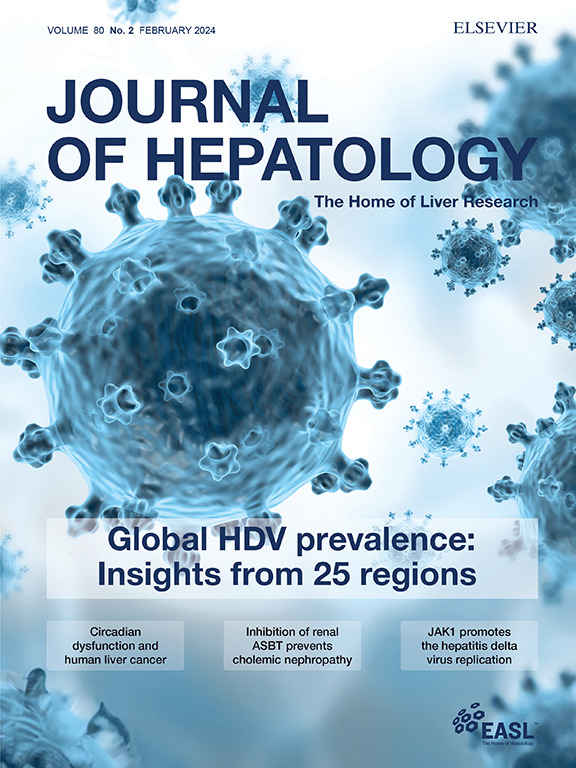MASLD与非肝脏相关死亡率:关联、独立关联和因果关系
IF 33
1区 医学
Q1 GASTROENTEROLOGY & HEPATOLOGY
引用次数: 0
摘要
MASLD与非肝脏相关死亡率:关联、独立关联和因果关系的差异MASLD患者存在较高的心脏代谢危险因素。事实上,MASLD的新定义正式要求至少存在一种心脏代谢危险因素,包括超重/肥胖、糖尿病或空腹血糖受损、高血压、高甘油三酯血症或血脂异常。因此,在瑞典登记的MASLD患者中,不良心血管事件和与这些心脏代谢相关的非肝脏恶性肿瘤导致的MASLD患者死亡率很高,这并不奇怪。Wester等人的研究对MASLD患者多学科护理和风险分层的意义在本期《国际肝病杂志》上,Wester等人在2002-2020年瑞典国家住院和专科门诊患者登记册中首次记录了来自瑞典的13,099例MASLD ICD-10代码(K76.0和K75.8)。将这些MASLD患者与从一般人群中确定的对照组进行比较,匹配年龄、性别、城市和日历年,并根据出生国家和修正CharlsonCaution进行调整,以解释MASLD与Wester等人报道的非肝脏相关死亡率过高之间的关系。Wester等人报道的MASLD与非肝脏相关死亡率之间的关联,必须在两个重要的潜在偏倚来源的背景下进行解释:a。选择偏见。MASLD病例来源于瑞典的住院和专科门诊记录(“瑞典国家患者登记册”),这些患者具有脂肪性肝病ICD-10代码的文件。这可能适用于一小部分病情较晚期的MASLD病例。只有13,099个MASLD与非肝脏相关死亡率的关联:三个不同研究的比较尽管Wester等人和Simon等人最近的一项研究报告了MASLD患者的非肝脏相关死亡率显著较高,但Younossi等人的一项研究发现MASLD与全因、心血管或癌症相关死亡率没有关联(表2)。为什么这些研究得出了如此不同的结论?三个研究中病例和对照的选择标准的比较以及混杂因素的不同调整水平可能解释了不同的结果和结论。Wester等人的研究很好地强调了MASLD患者心血管和癌症相关的高死亡率。大多数MASLD患者将死于心血管疾病和非hcc癌症,而不是肝脏相关死亡。这有力地证明了针对积极的危险因素修改的MASLD的多学科护理。然而,未入选的MASLD患者(现在越来越多的被诊断为非侵入性)是否有更高的心血管或癌症相关风险?免责声明本文内容不代表美国退伍军人事务部或美国政府的观点。本文未获得任何资金支持。本文章由计算机程序翻译,如有差异,请以英文原文为准。
MASLD and non-liver-related mortality: association, independent association and causality
Section snippets
MASLD and non-liver-related mortality: the difference between association, independent association and causality
Patients with MASLD have a high prevalence of cardiometabolic risk factors. Indeed, the new definition of MASLD formally requires the presence of at least one cardiometabolic risk factor, including overweight/obesity, diabetes or impaired fasting glucose, hypertension, hypertriglyceridemia or dyslipidemia[1]. Therefore, it should not be surprising that patients with MASLD experience high mortality from adverse cardiovascular events and non-hepatic malignancies related to these cardiometabolicCause-specific mortality in MASLD patients from Swedish registries: implications of study by Wester et al for multidisciplinary care and risk stratification of MASLD patients
In this issue of the Journal of Hepatology, Wester et al. identified 13,099 patients from Sweden who were first documented to have ICD-10 codes for MASLD ((K76.0 and K75.8) in the Swedish National Patient Register of inpatient and specialized outpatient care from 2002-2020[2]. These MASLD patients were compared to controls identified from the general population, matched for age, sex, municipality, and calendar year and additionally adjusting for country of birth and modified CharlsonCaution in interpreting the associations between MASLD and excess non-liver-related mortality reported by Wester et al: selection and confounding biases
The associations reported by Wester et al. between MASLD and excess non-liver-related mortality, must be interpreted in the context of two important potential sources of bias:- a.Selection bias. Cases of MASLD were derived from inpatient and specialized outpatient clinic records of Sweden (“Swedish National Patient Register”) who had documentation of ICD-10 codes for fatty liver disease. This is likely to select for a small subset of MASLD cases with more advanced disease. The fact that only 13,099
Associations of MASLD with non-liver-related mortality: comparison of three different studies
While Wester et al. and a recent study by Simon et al.[3] reported significantly higher non-liver-related mortality in patients with MASLD, a study by Younossi et al.[4] found no association between MASLD and all-cause, cardiovascular or cancer-related mortality (Table 2). Why did the studies reach such different conclusions?Comparison of the selection criteria for cases and controls and different levels of adjustment for confounders in the three studies likely explain the different results andConclusions
The study by Wester et al. nicely highlights the high cardiovascular and cancer-related mortality of patients with MASLD. Most patients with MASLD will die of cardiovascular disease and non-HCC cancers, rather than liver-related deaths. This argues strongly for multidisciplinary care of MASLD aiming at aggressive risk factor modification. However, whether unselected patients with MASLD (who are now increasingly being diagnosed non-invasively) have higher cardiovascular or cancer-relatedDisclaimer
The contents of this article do not represent the views of the US Department of Veterans Affairs or the US government.Financial Support
There was no financial support for this manuscript.求助全文
通过发布文献求助,成功后即可免费获取论文全文。
去求助
来源期刊

Journal of Hepatology
医学-胃肠肝病学
CiteScore
46.10
自引率
4.30%
发文量
2325
审稿时长
30 days
期刊介绍:
The Journal of Hepatology is the official publication of the European Association for the Study of the Liver (EASL). It is dedicated to presenting clinical and basic research in the field of hepatology through original papers, reviews, case reports, and letters to the Editor. The Journal is published in English and may consider supplements that pass an editorial review.
 求助内容:
求助内容: 应助结果提醒方式:
应助结果提醒方式:


